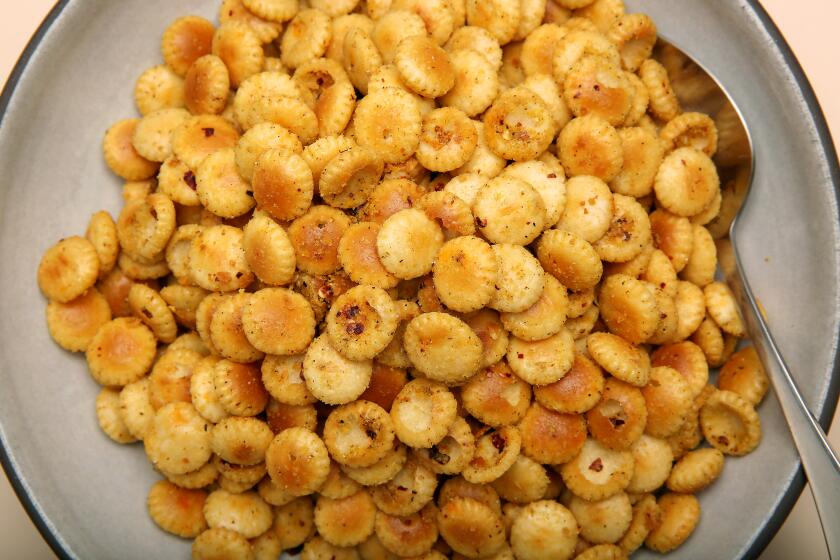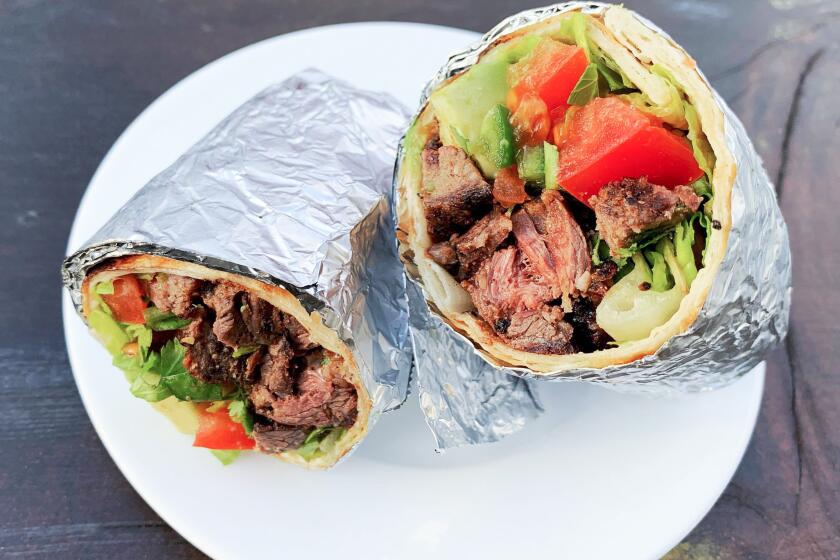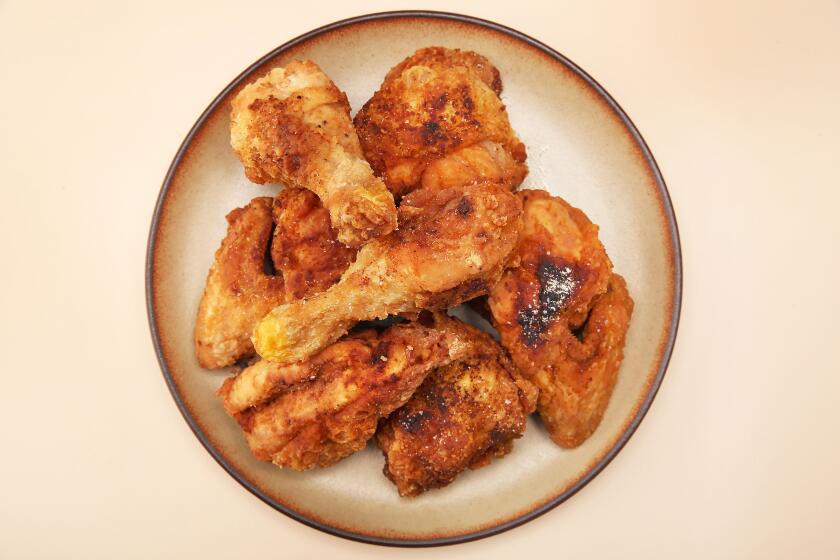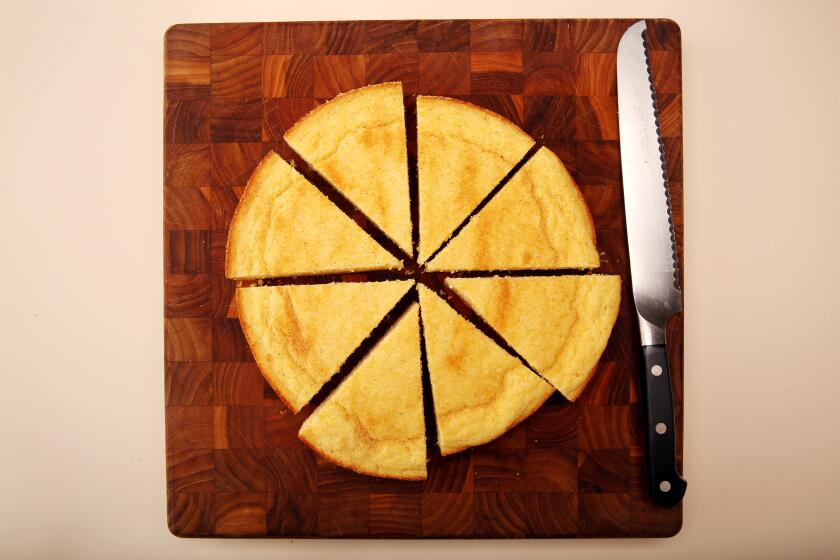For garlic powder, a working seasoning finally gets its turn in the spice limelight
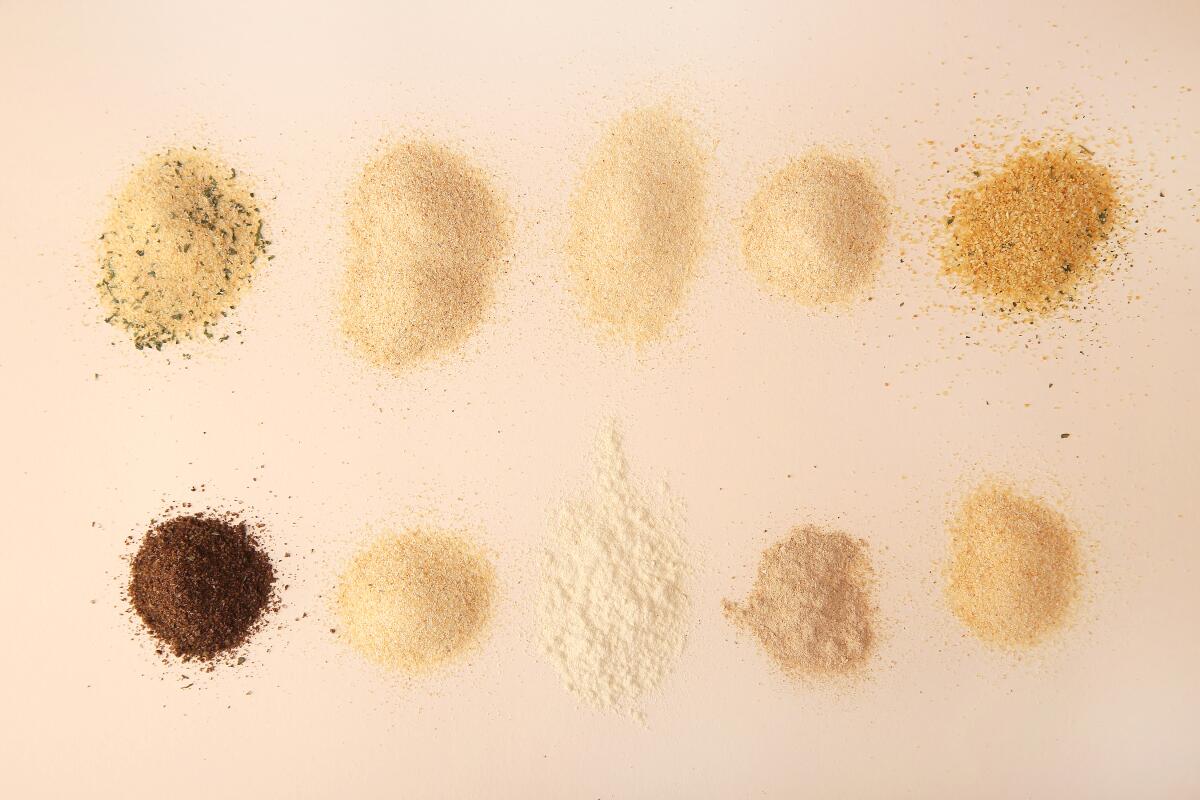
- Share via
Before the shutdown, most food media content was geared toward foodies and cooking enthusiasts, a community with a strong desire to learn about all the esoteric ingredients and equipment that people in my profession traffic in daily. But after the quarantine left everyone sheltered in place, people who never cared about cooking suddenly had to.
Our coverage at The Times pivoted quickly — to the most basic of cooking techniques and dishes to cater to a brand-new, mostly novice, audience. This shift taught me a few lessons: how much skill many Americans actually have in the kitchen, the limit of dishes they’ll wash in a day and, most important, what ingredients they actually cook with. And no ingredients have been representative of that last point more than dried herbs and spices.
According to Laurie Harrsen, senior director of North American consumer communications and PR at McCormick, “As Americans have been experiencing this ‘new normal,’ everyday spices, herbs and extracts have been there for taco night, baking with the kids, weeknight meals and inspiration for using ingredients found in the pantry. We have been receiving many consumer questions for how to use our spices instead of fresh in recipes.”
This “quarantine cooking” brought about a renewed interest in practical cooking, devoid of extraneous or pricey ingredients, and focusing on the quick, the fast and the super flavorful comfort food that people crave in times like this. In our quest for maximum flavor with minimum effort, an old faithful has returned to chip in: garlic powder. It’s an all-purpose seasoning, flavoring everything these days. As someone who cooked with it growing up but was trained out of using it professionally, it’s delightful to see.
Twelve years ago when I started working in highbrow food-media test kitchens, garlic powder was seen as a lifeless imitation of the fresh thing, trotted out to flavor only the barbecue sauces we’d develop for that big July Fourth story. Even then, it was used with reluctance and met with disdain from editors and colleagues. Why use dried garlic when fresh is so pungent, so aromatic, so flavorful? It was a question posed by a group of people who clearly had never tasted the outside of a breadstick at Olive Garden.
It was also a dictum that pervaded the industry — then deep in the throes of the farm-to-table movement and locavorism — where reverence for fresh ingredients signaled your bona fides. Meanwhile, home cooks — cooks we developed recipes for, cooks who bought the magazines and read the cooking articles we wrote — continued using garlic powder and other dried herbs and spices that were, and still are, essential to the American cooking pantry, whether or not the media recognize it.
In an ode to the similarly maligned onion powder in 2017, my friend and cookbook author Leah Koenig wrote: “While plenty of home cooks still use it, within the realm of chefs, food writers, and other tastemakers, it is generally regarded as old school — not in an exciting or authentic way, but in a snickering, ‘Can you believe people used to cook with condensed mushroom soup?’ way.” And, as she writes later, just because a spice is used in convenience products — condensed soups, boxed pasta salads, dry soup mixes — that contain fillers or other dubious ingredients, that shouldn’t mean the spice needs to suffer that same reputation.
Spiked with chile flakes, these salty snack crackers are a show-off for umami-packed garlic powder.
But now that everyone — not just enthusiasts — is cooking at home, these “old school” spices, particularly garlic powder, have reemerged from the back of the cabinet to help get dinner on the table more easily and efficiently, especially for people who probably never had a problem with some of those convenience foods and who don’t want to devote their entire day to preparing food.
Karla Vasquez, a food writer and online cooking instructor at SalviSoul, her website documenting Salvadoran foodways and recipes, told me: “It’s an ingredient that empowers people in the kitchen. Cooking has a lot of romance but also a lot of toil to it, you know? Garlic powder helps people skip a few steps to simplify the process. And it will yield consistent results every time you use it.”
That consistency is a boon to everyday home cooks, but garlic powder’s real rise to fame is more likely attributed to one of the biggest viral stars of our time being its cheerleader. As anyone familiar with TikTok will tell you, Tabitha Brown is the garlic powder queen. Sprinkled throughout her account are several cooking videos where she makes everyday vegan food for herself and her family. No matter what she’s making, she seasons it with garlic powder, either by itself or as part of spice mixes. For a vegan and Black woman, this is no accident, as author and African American culinary historian Michael Twitty points out.
“Garlic is big in the Black community because health is related to our community,” said Twitty. “The allicin in garlic powder is good for blood pressure, so you see it used in a way of cooking that’s close to the African diet, which is healthier than the Western diet. And so when you have Tabitha using garlic powder and talking about how eating vegan helped her health, this is where garlic meets the Afro-vegan movement — it’s something that makes nonmeat substitutes effortlessly have that umami flavor. That’s hard to do with clunky fresh garlic.”
Indeed, as Twitty points out, the resurgence of garlic powder in popular cooking — and other seasonings that include it — is tied directly to Black cooks, who’ve always used it in their cooking, which is gaining more exposure now that videos like Brown’s are reaching a wider audience on social media:
“We are garlic fiends in the Black community,” Twitty said. “Our cooking relies on a lot of rubs, so when you talk about fried chicken, barbecue, roasts, one-pot stews, that’s what we use. You go into Black people’s households and the spice cabinet is bursting with spices. White people have cinnamon,” Twitty added, laughing. “Like, why are there eight cinnamons?”
According to Twitty, the reasoning for the seasoning is two-fold. One is textural, while the second is pure economics: “You might rub garlic powder on meat and sear it, then you make your country stew or jambalaya. The ingredients have to be pungent but they also have to flow — no clunky stuff. We learned how to use it because garlic powder is economical and stays around longer. It’s a texture thing, but it’s a cost thing too.”
The economics of garlic powder raise another question that’s often glossed over when discussing the “fresh versus dried” dynamic in food media: Who has access to fresh? The answer is often as simple as what’s sold at your local grocery store.
“For Salvadorans, they’re shopping in the mercaditos and Latinx stores, and that determines what ingredients they cook with,” says Vasquez. “Like, why is it an ingredient that you can find in certain stores that serve different parts of the city but not others? In Mexican stores, you see garlic powder and garlic salt in the big display by the produce next to dried chiles, tamales, spice blends and tamarindos. You’re using it because it’s available where you shop.”
This tender steak has a nice chew beneath the crackle of its garlicky char and the limey tang of its meaty juices.
Indeed, because of its availability in certain markets, garlic powder has enjoyed wide use by predominantly Black and Latin communities for seasoning their food for generations — fried catfish, chicken or okra, Caribbean-style roast pork; none would have the same depth without garlic powder. It’s so much a part of that culture that when Black and Latin cooks talk about their food having “seasoning,” that word doesn’t refer just to the actual spices used to flavor it but to a certain soul the food possesses because it’s flavored to the max, and frequently garlic powder is that seasoning. Its ability to deliver a punch of flavor in a small dose might be the key to why garlic powder has, up until this year, never enjoyed the adoration of mainstream (i.e. white) food media: “It hurts people who like subtlety,” Twitty says, laughing.
But for many cooks, garlic powder — slightly sweeter and less pungent than fresh — builds on the familiar flavors of caramelized meat so much that the two are intertwined. It’s also why it’s the de facto seasoning in not just vegan cooking but for all vegetables.
“When carnivores eat vegetables, they want that umami flavor that things like garlic can duplicate as meaty-tasting flavors,” says Twitty. “Garlic powder makes people who wouldn’t like a certain food love it. If you are trying to eat more vegetables, throw in some garlic powder. You can say to yourself, ‘I’m really eating garlic but I’m also eating broccoli.’”
And while vegan and vegetarian cooks may use it to bring that umami depth to vegetable dishes, some meat cooks use it for the same quality but for a different reason: to reinforce the meaty flavor already present. Los Angeles’ barbecue master, Kevin Bludso — a judge on the Netflix cooking competition show “American Barbecue Showdown” — is one such cook, having used garlic powder his whole life. He learned early on to treat it as its own ingredient, not something to use only when fresh isn’t available.
“Garlic powder — or granulated garlic as we call it — melds with the meat and smoke to create that bark on the brisket that makes it perfect,” Bludso says. “It gets into the seams of the meat and gives it just a hint of garlic that brings out all the other flavors. People always say you can’t taste it, but if you don’t put it in, then you notice it’s missing! It’s just like cayenne: If you use it right, it’s an enhancer, but if you use too much, it overpowers everything.”
As essential as salt and pepper, here garlic powder highlights the umami sweetness of chicken in a simple, no-frills method.
As he reiterates, it even has more practical, physical purposes in food that fresh garlic can’t match. “My mother swore by it in fried chicken and pork chops. How are you gonna use fresh garlic in flour on your fried chicken? It needs to blend easily with the flour. You can’t use fresh garlic in barbecue rubs either, because it would just burn off.”
This unique characteristic of garlic powder — its ability to add a loaded dose of sweet funk where the pungent punch of fresh garlic has no business being — is also why it’s often used as the backbone for concentrated seasonings in potato chips, nut mixes and other salty snack mixes. In fact, my favorite treat from my childhood in the South uses it as the primary flavoring. Called “firecrackers,” saltines — or “soup and oyster” crackers in my home — are doused in oil flavored with the umami-packed allium along with onion powder, dried ranch dressing powder and plenty of crushed red chile flakes. After the initial heat of the chile flakes subsides, you get the salty sweetness from the garlic powder that makes you reactively grab another handful.
It’s a common snack in households across the South because it uses ingredients everyone has. And whether all home cooks will admit it or not, everyone has garlic powder. It’s this ubiquity that led Burlap & Barrel, a New York-based spice company known for selling a meticulously curated collection of single-origin spices, to begin carrying garlic powder in its inventory.
“I really wanted it in our lineup because I use it and love it and think it really elevates the flavor of a dish, especially savory baked goods like cornbread,” says Burlap & Barrel cofounder Ori Zohar. “And when we looked at what the cooks were actually using, we realized that everyone has garlic powder in their pantry. But, at the same time, a big consideration for inclusion in our spice lineup is always to pick spices that are really flavorful and have a great story, and garlic powder is typically neither of those things.”
Garlic powder, dusted over the top, plays off the sweetness of cornmeal in this simple cornbread.
But a trip to Vietnam early last year found Zohar and business partner Ethan Frisch tasting a garlic that met their standards and was worth preserving for their customers.
“There was a group of farmers growing purple-stripe garlic, so we tried it,” says Zohar. “Theirs was much more fragrant and had a more concentrated garlic flavor than the larger Chinese-grown type. As it dries, it produces notes of lemongrass and basil. We knew this could change the haters’ perceptions of what ground garlic could be like.”
Indeed, its story starts as being cast as a cheap, convenient way to add flavor to humble food — a reputation it suffered from for many years — and being denigrated for how it compares to its fresh counterpart. Now it’s lauded by social media cooking stars and has bespoke versions sold by discerning spice companies. Prized once again for its indispensability, you could say that garlic powder has finally arrived. But then again, it never really went anywhere. Like that dependable working actor — you know their face but not their name — whose career we don’t appreciate until it outlasts that of the flashier movie stars, garlic powder was under our noses the whole time, waiting for us to realize what a good thing we’ve always had.
Get the recipes:
Garlic Fried Chicken
Garlic-Crusted Cornbread
Firecrackers
More to Read
Eat your way across L.A.
Get our weekly Tasting Notes newsletter for reviews, news and more.
You may occasionally receive promotional content from the Los Angeles Times.
